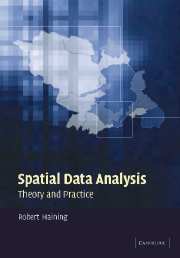Book contents
- Frontmatter
- Contents
- Preface
- Acknowledgements
- Introduction
- Part A The context for spatial data analysis
- Part B Spatial data: obtaining data and quality issues
- Part C The exploratory analysis of spatial data
- 5 Exploratory spatial data analysis: conceptual models
- 6 Exploratory spatial data analysis: visualization methods
- 7 Exploratory spatial data analysis: numerical methods
- Part D Hypothesis testing and spatial autocorrelation
- Part E Modelling spatial data
- Appendix I Software
- Appendix II Cambridgeshire lung cancer data
- Appendix III Sheffield burglary data
- Appendix IV Children excluded from school: Sheffield
- References
- Index
6 - Exploratory spatial data analysis: visualization methods
Published online by Cambridge University Press: 06 July 2010
- Frontmatter
- Contents
- Preface
- Acknowledgements
- Introduction
- Part A The context for spatial data analysis
- Part B Spatial data: obtaining data and quality issues
- Part C The exploratory analysis of spatial data
- 5 Exploratory spatial data analysis: conceptual models
- 6 Exploratory spatial data analysis: visualization methods
- 7 Exploratory spatial data analysis: numerical methods
- Part D Hypothesis testing and spatial autocorrelation
- Part E Modelling spatial data
- Appendix I Software
- Appendix II Cambridgeshire lung cancer data
- Appendix III Sheffield burglary data
- Appendix IV Children excluded from school: Sheffield
- References
- Index
Summary
This chapter focuses on visualization tools for exploratory spatial data analysis whilst chapter 7deals with numerical tools and fitting. Visualizing data has come to mean both the construction of graphs and fits but also a process of interacting with the parameters of the graph. Visualization has acquired a distinctive status in the conduct of exploratory data analysis for at least two reasons. First, advances in computing have made it possible to visually examine data quickly and easily and in more informative ways. Second, graphical tools are often more intuitive for the non-specialist. This means people who are not statisticians but who have knowledge of the subject area and can bring subject matter context to the analysis may be better able to participate in the process of getting data insights.
Section 6.1 discusses visualization, identifying the data analytic tasks it is used for, classifying data visualization approaches and describing some of the techniques that are available for EDA. Section 6.2 considers the visualization of spatial data including discussion of some data preparation issues and the special problems associated with the visualization of spatial data. Section 6.3 discusses visualization techniques that have been developed for spatial data and these are classified by the types of spatial pattern the analyst might be interested in looking for as part of ESDA (see chapter 5). The chapter concludes with a short illustrative example.
- Type
- Chapter
- Information
- Spatial Data AnalysisTheory and Practice, pp. 188 - 225Publisher: Cambridge University PressPrint publication year: 2003



